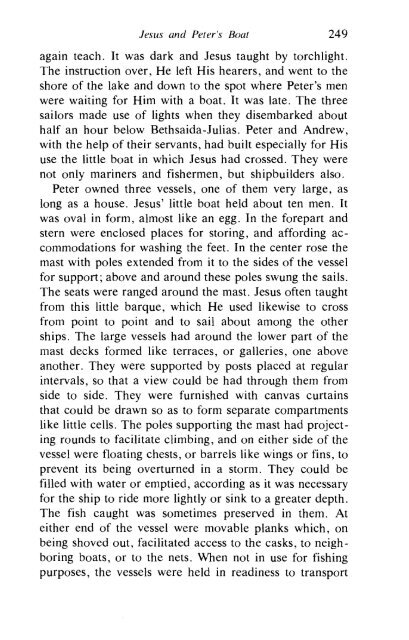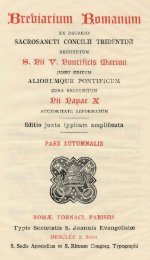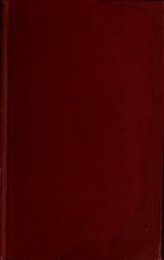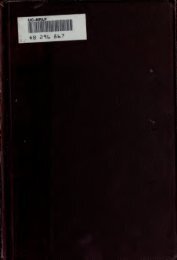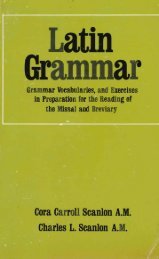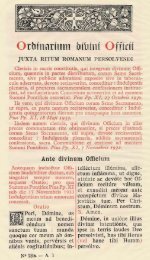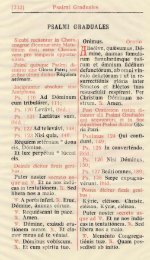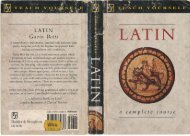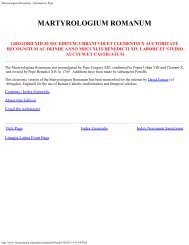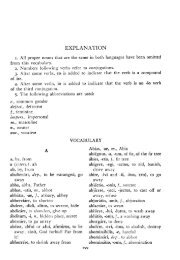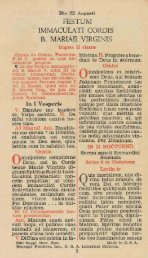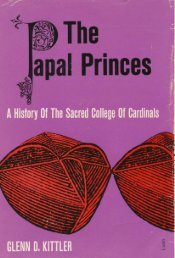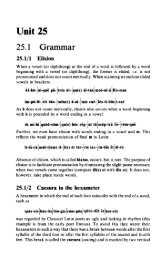- Page 1 and 2:
CONTENTS OF VOLUME II JESUS IN THE
- Page 3 and 4:
Contents xvii 5. Jesus in Nazareth.
- Page 5 and 6:
THE LIFE OF JESUS CHRIST and BIBLIC
- Page 7 and 8:
2 Life of Jesus Christ not so high
- Page 9 and 10:
4 Life of Jesus Christ baptism, abo
- Page 11 and 12:
6 Life of Jesus Christ the lower po
- Page 13 and 14:
8 Life of Jesus Christ tion. There
- Page 15:
10 Life of Jesus Christ proach timi
- Page 19 and 20:
14 Life of Jesus Christ than usual
- Page 21 and 22:
16 Life of Jesus Christ The tree wa
- Page 23 and 24:
18 Life of Jesus Christ bearing wit
- Page 25 and 26:
20 Life of Jesus Christ ing baptism
- Page 27:
22 Life of Jesus Christ them to the
- Page 30 and 31:
Jesus at Ophra 25 not exactly wicke
- Page 32 and 33:
Jesus at Eleale 27 In the synagogue
- Page 37 and 38:
32 Life of Jesus Christ extended th
- Page 40 and 41:
Call or lJ/'f/:'T. Philip. und Naih
- Page 42:
Jesus at Capharnaum 37 ging Andrew
- Page 46:
part over a mountain. The women cho
- Page 50:
The Wedding at Cana 45 This aunt al
- Page 54:
The Nuptial Ceremony 49 more richly
- Page 58 and 59:
Nuptial Banquet 53 of Mary and Jose
- Page 60 and 61:
The Wine Fails 55 My hour is not ye
- Page 62 and 63:
The Water Changed to Wine 57 ble ha
- Page 64 and 65:
Jesus in Capharnaum 59 thenl. The p
- Page 66 and 67:
The Lord's Prayer 61 wall, upon whi
- Page 68 and 69:
The Place of Baptism 63 From this p
- Page 70 and 71:
Baptism at the Jordan whether He wa
- Page 72 and 73:
Baptism at the Jordan 67 the water
- Page 74 and 75:
The Dead Sea 69 and on them once st
- Page 76 and 77:
Feast of the New Moon I saw that th
- Page 78 and 79:
Jesus in Adummin 73 was in some pla
- Page 80 and 81:
Jesus in Nebo 75 ministered. The ba
- Page 82 and 83:
Jesus Goes to Galilee 77 alms which
- Page 84 and 85:
Mary Magdalen 79 Lazarus, Martha, S
- Page 86 and 87:
Jesus in Capharnaum notwithstanding
- Page 88 and 89:
Jesus at Chisloth 83 place, but the
- Page 90 and 91:
Jesus Teaches and Cures 85 Zabulon
- Page 92 and 93:
Jesus Teaching Near Jezrael 87 From
- Page 94 and 95:
Jesus Teaching in Sunem 89 know not
- Page 96:
Jesus Teaching in Ulama 91 Ulama ha
- Page 99 and 100:
94 Life of Jesus Christ two other m
- Page 101 and 102:
96 Life of Jesus Christ Jesus and t
- Page 103 and 104:
98 Life of Jesus Christ words to de
- Page 106 and 107:
The Feast of Purim 101 tablets with
- Page 108 and 109:
Jesus and Lazarus 103 handsome and
- Page 110 and 111:
First Paschal Celebration 105 women
- Page 112 and 113:
Simon the Pharisee 107 ing of the K
- Page 114:
Jesus in the Temple 109 thoughts to
- Page 118 and 119:
Mary the Silent 113 tions and asked
- Page 120 and 121:
Jesus in the Temple 115 eatables. I
- Page 122 and 123:
Preparations for the Pasch 117 coun
- Page 124 and 125:
The Paschal Supper 119 different al
- Page 126 and 127:
Jesus Keeps the Sabbath 121 doves,
- Page 128 and 129:
FROM THE CLOSE OF THE FIRST PASCH T
- Page 130 and 131:
Jesus' Picture 125 these gifts from
- Page 132 and 133:
Jesus and Bartholomew 127 Bartholom
- Page 134 and 135:
Sichor Libnath 129 resunle His publ
- Page 137 and 138:
132 Life of Jesus Christ cures; ind
- Page 140:
Jesus Blesses a Well 135 Many of th
- Page 143 and 144:
138 Life of Jesus Christ before rea
- Page 145 and 146:
140 Life of Jesus Christ Governor's
- Page 148 and 149:
Wonderful Conversion 143 animals be
- Page 150:
Jesus Teaching 145 mentioned signs.
- Page 153 and 154:
148 Life of Jesus Christ that he he
- Page 155 and 156:
150 Life of Jesus Christ After the
- Page 157 and 158:
152 Life of Jesus Christ as various
- Page 159 and 160:
154 Life of Jesus Christ In Seleuci
- Page 161 and 162:
156 Life of Jesus Christ what He th
- Page 163 and 164:
158 Life of Jesus Christ the evil o
- Page 165 and 166:
160 Life of Jesus Christ instructio
- Page 167 and 168:
162 Life of Jesus Christ other gues
- Page 169 and 170:
164 Life of Jesus Christ His persec
- Page 171:
166 Life of Jesus Christ through wh
- Page 174:
Jesus in Bethania 169 by the princi
- Page 178 and 179:
Inns Established 173 murdering his
- Page 180 and 181:
The Precious Pearl 175 nearest pear
- Page 182 and 183:
Jesus in Bethoron 177 again in seve
- Page 184 and 185:
Trials qf the Disciples 179 nouncin
- Page 186:
Jacob's Well 181 lying across the w
- Page 190 and 191:
The Living Water 185 souls of Samar
- Page 192 and 193:
Jesus Declares Himse(f the Messiah
- Page 194:
Dina's People 189 in Sichar as a nl
- Page 197 and 198:
192 Life of Jesus Christ they had r
- Page 202 and 203:
The Pharisees 197 be unrecognizable
- Page 204 and 205: The Pharisees Lay a Snare for Jesus
- Page 206 and 207: The Centurion's Son 201 Jesus went
- Page 209 and 210: 204 Life of Jesus Christ Seeing thi
- Page 212 and 213: JESUS' TEACHING MISSION IN THE COUN
- Page 214 and 215: The Centurion Zorobabel 209 Jesus p
- Page 216 and 217: Jesus Goes to Capharnaum 211 seduce
- Page 218: Jesus Preaches on the Sabbath 213 P
- Page 221: 216 Life of Jesus Christ the street
- Page 225 and 226: 220 Life of Jesus Christ well; had
- Page 227: 222 Life of Jesus Christ flowed fro
- Page 230 and 231: Andre») and His Wife 225 giving th
- Page 232 and 233: The Jewish Law 227 tassels and lace
- Page 234 and 235: Manner of Jesus' Curing 229 models
- Page 236 and 237: The Law of Divorce 231 said that if
- Page 238 and 239: Jesus in Nazareth 233 of the Precur
- Page 240 and 241: Jesus in Nazareth 235 and the punis
- Page 242 and 243: "Halt! Where Is He? Halt!" 237 beli
- Page 244 and 245: Cure of Lepers 239 step aside. He d
- Page 246: Jesus' Teaching on True Love of Nei
- Page 250 and 251: Jesus Cures the Possessed 245 them
- Page 252 and 253: Jesus Instructs the Heathens 247 To
- Page 256 and 257: Jesus in Peter's House 251 returned
- Page 258: "Rise! Thy Sins are Forgiven Thee!"
- Page 261 and 262: 256 Life of Jesus Christ followed H
- Page 263 and 264: 258 Life of Jesus Christ great deal
- Page 265 and 266: 260 Life of Jesus Christ secute Him
- Page 267 and 268: 262 L(fe of Jesus Christ has done g
- Page 269 and 270: 264 Life of Jesus Christ worldly so
- Page 272 and 273: At the Baths 267 a circle, and at t
- Page 274 and 275: The Region Around Bethulia 269 ing
- Page 276 and 277: Discourse at Bethulia 271 When the
- Page 278 and 279: Jesus in Jetebatha 273 in Heaven?"
- Page 280 and 281: Jesus anzong the Harvesters 275 her
- Page 282 and 283: Jes us Among the Harvesters 277 for
- Page 284 and 285: Herod Interrogates John the Baptist
- Page 286: Jes us in the Synogogue 281 Jerusal
- Page 289 and 290: 284 Life of Jesus Christ entrance t
- Page 291 and 292: 286 Life of Jesus Christ and still
- Page 293 and 294: 288 Life of Jesus Christ implored M
- Page 299 and 300: 294 Life of Jesus Christ another by
- Page 301 and 302: 296 Life of Jesus Christ cakes, and
- Page 303 and 304: 298 Life of Jesus Christ Tower of B
- Page 305 and 306:
300 Life of Jesus Christ There were
- Page 308 and 309:
Jesus Outside Bezech 303 During the
- Page 310:
Jesus at Bezech 305 Pharisees, who
- Page 314 and 315:
Jes us Cures the Sick 309 revenger
- Page 316 and 317:
Jesus Goes to Ennol1 311 whether He
- Page 318:
The Adulteress 313 pearls. She wore
- Page 321 and 322:
316 L(fe of Jesus Christ all sides,
- Page 324 and 325:
The Region of the Jahok 319 assurin
- Page 326:
Ramoth-Galaad 321 and stayed overni
- Page 330 and 331:
History of Jephte 325 distance from
- Page 332 and 333:
Sacrifice of Jephtias 327 as was cu
- Page 334 and 335:
Jephtias's Monument 329 heathens. I
- Page 337 and 338:
332 Life of Jesus Christ pray. Arga
- Page 339 and 340:
334 Life of Jesus C1zrist of their
- Page 341 and 342:
336 Life of Jesus Christ souls in a
- Page 344 and 345:
Gedeon and the Madianites 339 The a
- Page 346 and 347:
Jesus Travels to Ephron 341 were di
- Page 348 and 349:
Betharamphtha-Julias 343 from which
- Page 350:
The New Year Celebration 345 consIs
- Page 353 and 354:
348 Life of Jesus Christ birds that
- Page 355 and 356:
350 Life of Jesus Christ Isaac, Jes
- Page 357 and 358:
352 Life of Jesus Christ daughter o
- Page 359:
354 Life of Jesus Christ they allow
- Page 362 and 363:
Jesus in Gadara 357 Nathanael (Chas
- Page 366:
Moloch 361 soon spread. The place t
- Page 369 and 370:
364 Life of Jesus Christ vessel by
- Page 371 and 372:
366 Life of Jesus Christ burning pe
- Page 373 and 374:
368 Life of Jesus Christ chariot, o
- Page 375:
370 L(fe of Jesus Lnrist from the v
- Page 378 and 379:
FROM THE SECOND FEAST OF TABERNACLE
- Page 380 and 381:
Celebration of the Feast of Taberna
- Page 382:
Jesus Returns from Ennon to Socoth
- Page 385 and 386:
380 Life of Jesus Christ grating, t
- Page 387:
382 L((e of Jesus Cnrist tears tlo\
- Page 390 and 391:
Jesus in Akrabis 385 house. He gave
- Page 392 and 393:
Jesus in Silo 387 tabernacles outsi
- Page 395 and 396:
390 Life of Jesus Christ fell at Je
- Page 397 and 398:
392 Life of Jesus Christ before he
- Page 399 and 400:
394 Life of Jesus Christ mountains
- Page 401 and 402:
396 Life of Jesus Christ naum to Jo
- Page 403 and 404:
398 Lit'e (j( Jesus ChrisT and that
- Page 405 and 406:
400 Life of Jesus ('hrist 12 and Is
- Page 407:
402 Life of Jesus Christ something
- Page 410:
Jesus in Thanath-Silo 405 4. JESUS
- Page 413 and 414:
408 L((e q( Jesus Christ others. He
- Page 415 and 416:
4]0 Lifi: of }/;,SUS Chris! ceded H
- Page 417 and 418:
412 .l){e of Jesus Christ Obed hilT
- Page 419:
414 Life of Jesus Christ warned Obe
- Page 422:
Jesus in Meraz 417 aqueduct and had
- Page 425 and 426:
420 Life of Jesus Christ honors, di
- Page 428 and 429:
Judas Joins the Disciples 423 tion
- Page 433:
428 Life of Jesus Christ daughters
- Page 438:
Jesus in Dothan 433 were put into s
- Page 441 and 442:
436 Life of Jesus Christ assembled
- Page 443 and 444:
438 Life of Jesus Christ partitions
- Page 445 and 446:
440 Life of Jesus Christ tain and i
- Page 447 and 448:
442 Life of Jesus Christ pense of o
- Page 449 and 450:
444 Life of Jesus Christ pagan howe
- Page 452 and 453:
Jesus in Abez 447 that He knew bett
- Page 454 and 455:
King Saul 449 SAUL AND THE WITCH OF
- Page 456 and 457:
Jesus in Dabereth 451 ing at the nl
- Page 458:
Jesus in Dabereth 453 were very pio
- Page 462 and 463:
The Pharisees, Sadducees, and Herod
- Page 464 and 465:
Cyrinus of Cyprus 459 kling in the
- Page 466 and 467:
Giskala 461 10. JESUS GOES TO GISKA
- Page 468 and 469:
Jesus Prophesies of Three Zealots 4
- Page 470 and 471:
Achias 465 had no liking for the of
- Page 472 and 473:
Jesus' Instruction near Gabara 467
- Page 474 and 475:
Magdalen 469 Martha treated her ver
- Page 476 and 477:
The Mount of Instruction 471 They,
- Page 480 and 481:
The Pharisees 475 tion of all was r
- Page 482 and 483:
Magdalen 477 tures drew near to Jes
- Page 484 and 485:
Magdalen 479 Magdalen, and exchange
- Page 486:
Magdalen 481 affectionate girl, and


